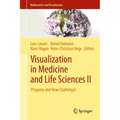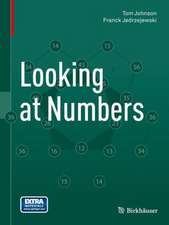Computational Diffusion MRI: MICCAI Workshop, Athens, Greece, October 2016: Mathematics and Visualization
Editat de Andrea Fuster, Aurobrata Ghosh, Enrico Kaden, Yogesh Rathi, Marco Reiserten Limba Engleză Hardback – 13 mai 2017
Over the last decade, interest in diffusion MRI has virtually exploded. The technique provides unique insights into the microstructure of living tissue and enables in-vivo connectivity mapping of the brain. Computational techniques are key to the continued success and development of diffusion MRI and to its widespread transfer into the clinic, while new processing methods are essential to addressing issues at each stage of the diffusion MRI pipeline: acquisition, reconstruction, modeling and model fitting, image processing, fiber tracking, connectivity mapping, visualization, group studies and inference.
These papers from the 2016 MICCAI Workshop “Computational Diffusion MRI” – which was intended to provide a snapshot of the latest developments within the highly active and growing field of diffusion MR – cover a wide range of topics, from fundamental theoretical work on mathematical modeling, to the development and evaluation of robust algorithms and applications in neuroscientific studies and clinical practice. The contributions include rigorous mathematical derivations, a wealth of rich, full-color visualizations, and biologically or clinically relevant results. As such, they will be of interest to researchers and practitioners in the fields of computer science, MR physics, and applied mathematics.
| Toate formatele și edițiile | Preț | Express |
|---|---|---|
| Paperback (2) | 590.12 lei 38-44 zile | |
| Springer International Publishing – 25 apr 2018 | 590.12 lei 38-44 zile | |
| Springer International Publishing – 28 iul 2018 | 636.94 lei 6-8 săpt. | |
| Hardback (2) | 592.35 lei 38-44 zile | |
| Springer International Publishing – 9 apr 2016 | 592.35 lei 38-44 zile | |
| Springer International Publishing – 13 mai 2017 | 643.16 lei 6-8 săpt. |
Din seria Mathematics and Visualization
- 20%
 Preț: 935.20 lei
Preț: 935.20 lei - 18%
 Preț: 960.93 lei
Preț: 960.93 lei - 18%
 Preț: 1110.41 lei
Preț: 1110.41 lei - 20%
 Preț: 994.26 lei
Preț: 994.26 lei - 18%
 Preț: 1220.57 lei
Preț: 1220.57 lei - 18%
 Preț: 958.38 lei
Preț: 958.38 lei - 15%
 Preț: 654.62 lei
Preț: 654.62 lei - 20%
 Preț: 997.38 lei
Preț: 997.38 lei - 15%
 Preț: 645.47 lei
Preț: 645.47 lei - 5%
 Preț: 1101.58 lei
Preț: 1101.58 lei - 20%
 Preț: 992.44 lei
Preț: 992.44 lei - 20%
 Preț: 1284.47 lei
Preț: 1284.47 lei - 20%
 Preț: 656.69 lei
Preț: 656.69 lei - 20%
 Preț: 476.68 lei
Preț: 476.68 lei - 20%
 Preț: 1273.08 lei
Preț: 1273.08 lei - 15%
 Preț: 649.54 lei
Preț: 649.54 lei - 20%
 Preț: 335.36 lei
Preț: 335.36 lei - 20%
 Preț: 646.95 lei
Preț: 646.95 lei - 20%
 Preț: 651.75 lei
Preț: 651.75 lei - 20%
 Preț: 657.99 lei
Preț: 657.99 lei - 18%
 Preț: 1223.74 lei
Preț: 1223.74 lei - 20%
 Preț: 333.72 lei
Preț: 333.72 lei - 20%
 Preț: 709.98 lei
Preț: 709.98 lei - 18%
 Preț: 1236.38 lei
Preț: 1236.38 lei - 20%
 Preț: 992.26 lei
Preț: 992.26 lei - 20%
 Preț: 648.44 lei
Preț: 648.44 lei - 20%
 Preț: 1158.59 lei
Preț: 1158.59 lei - 20%
 Preț: 330.66 lei
Preț: 330.66 lei - 18%
 Preț: 963.91 lei
Preț: 963.91 lei - 15%
 Preț: 653.98 lei
Preț: 653.98 lei - 20%
 Preț: 991.94 lei
Preț: 991.94 lei - 18%
 Preț: 958.07 lei
Preț: 958.07 lei
Preț: 643.16 lei
Preț vechi: 756.65 lei
-15% Nou
Puncte Express: 965
Preț estimativ în valută:
123.07€ • 128.84$ • 101.83£
123.07€ • 128.84$ • 101.83£
Carte tipărită la comandă
Livrare economică 05-19 aprilie
Preluare comenzi: 021 569.72.76
Specificații
ISBN-13: 9783319541297
ISBN-10: 3319541293
Pagini: 212
Ilustrații: XI, 212 p. 70 illus., 66 illus. in color.
Dimensiuni: 155 x 235 x 14 mm
Greutate: 0.49 kg
Ediția:1st ed. 2017
Editura: Springer International Publishing
Colecția Springer
Seria Mathematics and Visualization
Locul publicării:Cham, Switzerland
ISBN-10: 3319541293
Pagini: 212
Ilustrații: XI, 212 p. 70 illus., 66 illus. in color.
Dimensiuni: 155 x 235 x 14 mm
Greutate: 0.49 kg
Ediția:1st ed. 2017
Editura: Springer International Publishing
Colecția Springer
Seria Mathematics and Visualization
Locul publicării:Cham, Switzerland
Cuprins
The MR Physics of Advanced Diffusion Imaging: Matt Hall.- Noise Floor Removal via Phase Correction of Complex Diffusion-Weighted Images: Influence on DTI and q-Space Metrics: M. Pizzolato et al.- Regularized Dictionary Learning with Robust Sparsity Fitting for Compressed Sensing Multishell HARDI: K. Gupta et al.- Denoising Diffusion-Weighted Images Using Grouped Iterative Hard Thresholding of Multi-Channel Framelets: Jian Zhang et al.- Diffusion MRI Signal Augmentation – From Single Shell to Multi Shell with Deep Learning: S. Koppers et al.- Multi-Spherical Diffusion MRI: Exploring Diffusion Time Using Signal Sparsity: R.H.J. Fick et al.- Sensitivity of OGSE ActiveAx to Microstructural Dimensions on a Clinical Scanner: L.S. Kakkar et al.- Groupwise Structural Parcellation of the Cortex: A Sound Approach Based on Logistic Models: G. Gallardo et al.- Robust Construction of Diffusion MRI Atlases with Correction for Inter-Subject Fiber Dispersion: Z. Yang et al.- Parcellation of Human Amygdala Subfields Using Orientation Distribution Function and Spectral K-means Clustering: Q. Wen et al.- Sparse Representation for White Matter Fiber Compression and Calculation of Inter-Fiber Similarity: G. Zimmerman Moreno et al.- An Unsupervised Group Average Cortical Parcellation using Diffusion MRI to Probe Cytoarchitecture: T. Ganepola et al.- Using multiple Diffusion MRI Measures to Predict Alzheimer’s Disease with a TV-L1 Prior: J.E. Villalon-Reina et al.- Accurate Diagnosis of SWEDD vs. Parkinson Using Microstructural Changes of Cingulum Bundle: Track-Specific Analysis: F. Rahmani et al.- Colocalization of Functional Activity and Neurite Density within Cortical Areas: A. Teillac et al.- Comparison of Biomarkers in Transgenic Alzheimer Rats Using Multi-shell Diffusion MRI: R.H.J. Fick.- Working Memory Function in Recent-onset Schizophrenia Patients Associated with White Matter Microstructure: Connectometry Approach: M. Dolatshahi et al.
Textul de pe ultima copertă
This volume offers a valuable starting point for anyone interested in learning computational diffusion MRI and mathematical methods for brain connectivity, while also sharing new perspectives and insights on the latest research challenges for those currently working in the field.
Over the last decade, interest in diffusion MRI has virtually exploded. The technique provides unique insights into the microstructure of living tissue and enables in-vivo connectivity mapping of the brain. Computational techniques are key to the continued success and development of diffusion MRI and to its widespread transfer into the clinic, while new processing methods are essential to addressing issues at each stage of the diffusion MRI pipeline: acquisition, reconstruction, modeling and model fitting, image processing, fiber tracking, connectivity mapping, visualization, group studies and inference.
These papers from the 2016 MICCAI Workshop “Computational Diffusion MRI” – which was intended to provide a snapshot of the latest developments within the highly active and growing field of diffusion MR – cover a wide range of topics, from fundamental theoretical work on mathematical modeling, to the development and evaluation of robust algorithms and applications in neuroscientific studies and clinical practice. The contributions include rigorous mathematical derivations, a wealth of rich, full-color visualizations, and biologically or clinically relevant results. As such, they will be of interest to researchers and practitioners in the fields of computer science, MR physics, and applied mathematics.
Over the last decade, interest in diffusion MRI has virtually exploded. The technique provides unique insights into the microstructure of living tissue and enables in-vivo connectivity mapping of the brain. Computational techniques are key to the continued success and development of diffusion MRI and to its widespread transfer into the clinic, while new processing methods are essential to addressing issues at each stage of the diffusion MRI pipeline: acquisition, reconstruction, modeling and model fitting, image processing, fiber tracking, connectivity mapping, visualization, group studies and inference.
These papers from the 2016 MICCAI Workshop “Computational Diffusion MRI” – which was intended to provide a snapshot of the latest developments within the highly active and growing field of diffusion MR – cover a wide range of topics, from fundamental theoretical work on mathematical modeling, to the development and evaluation of robust algorithms and applications in neuroscientific studies and clinical practice. The contributions include rigorous mathematical derivations, a wealth of rich, full-color visualizations, and biologically or clinically relevant results. As such, they will be of interest to researchers and practitioners in the fields of computer science, MR physics, and applied mathematics.
Caracteristici
Careful mathematical derivations Large number of rich full-color visualizations Biologically or clinically relevant results
















